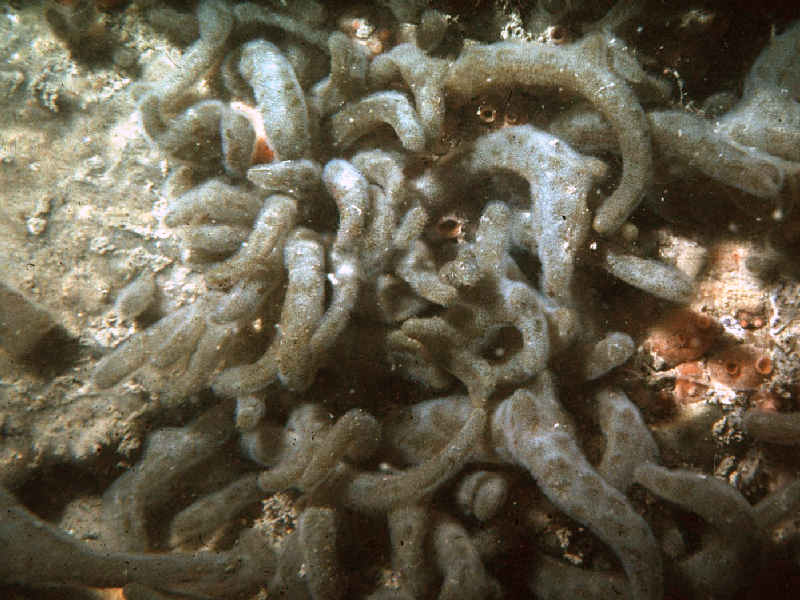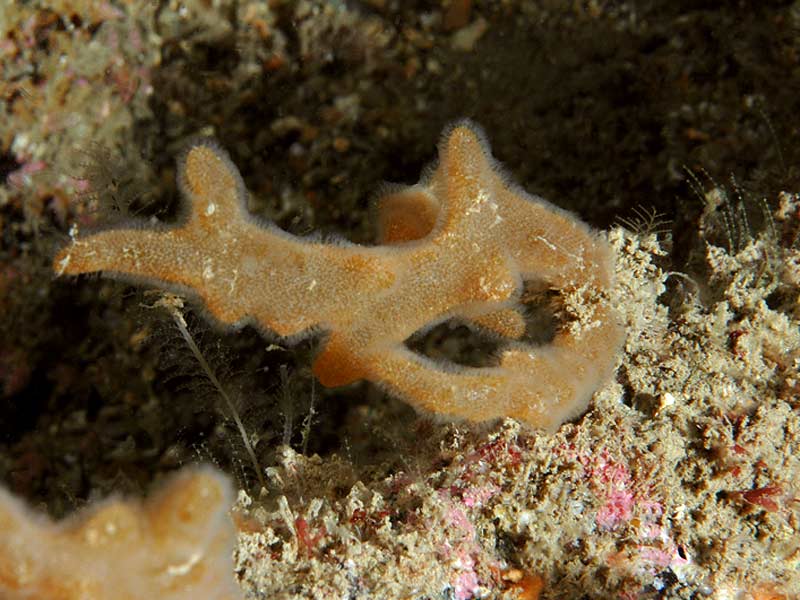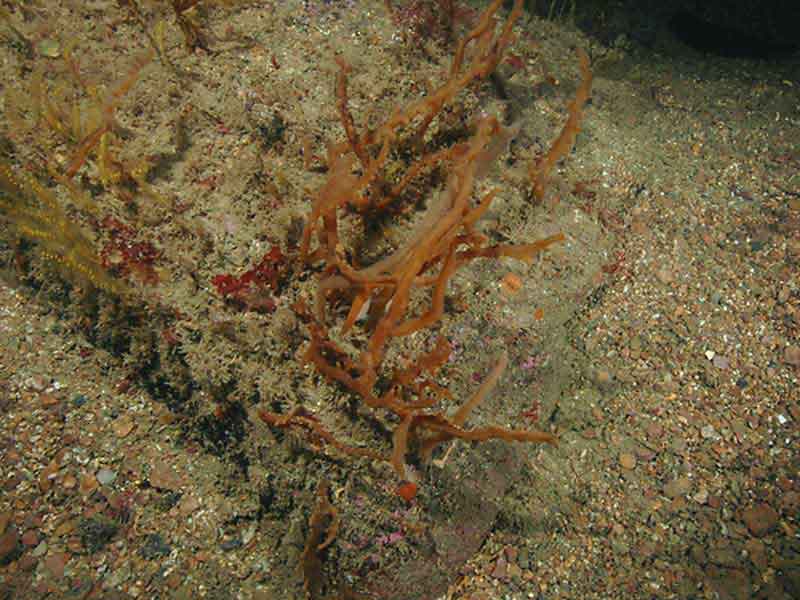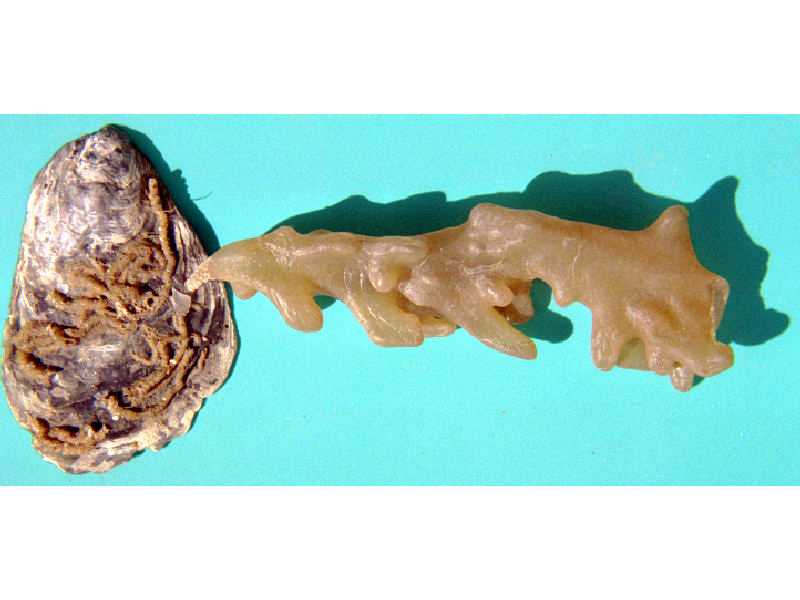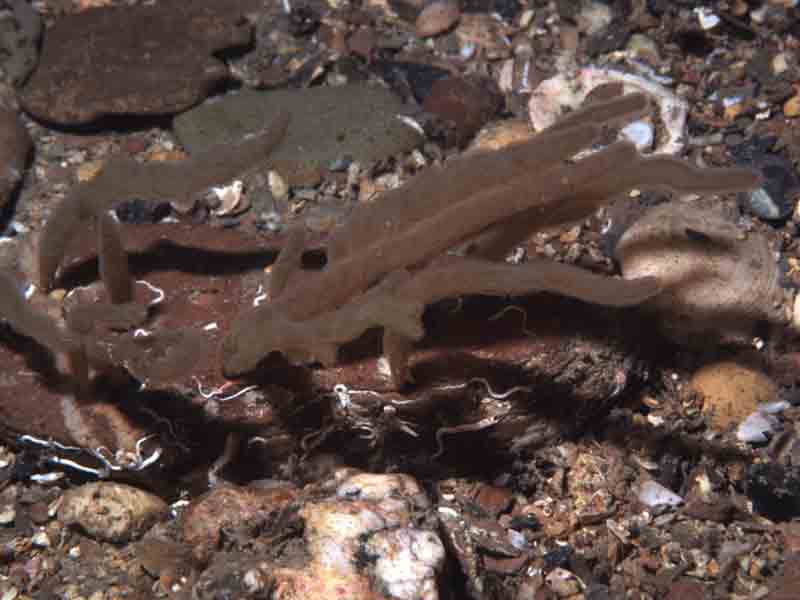Sea chervil (Alcyonidium diaphanum)
Distribution data supplied by the Ocean Biodiversity Information System (OBIS). To interrogate UK data visit the NBN Atlas.Map Help
| Researched by | Olwen Ager | Refereed by | Admin |
| Authority | (Hudson, 1778) | ||
| Other common names | - | Synonyms | - |
Summary
Description
Recorded distribution in Britain and Ireland
Found around all British and Ireland coasts.Global distribution
Common off all north European coasts.Habitat
Alcyonidium diaphanum is found attached to rocks, shells or stones from the lower intertidal zone to shelly sands and coarse grounds offshore.Depth range
-Identifying features
- Erect colony up to 50 cm high.
- Surface smooth, occasionally knobbly.
- Firmly gelatinous.
- Variable colour; brown, yellow, reddish, grey or colourless.
- Variable shape and size.
Additional information
Other common names include "curly weed", "amber weed" and ju-ju weed" (Pathmanaban et al., 2005).Alcyonidium diaphanum is responsible for the allergic contact dermatitis, termed 'Dogger Bank Itch', experienced mostly by fishermen and dock workers (Pathmanaban et al., 2005). Although previously not reported from any other fishing grounds around the British Isles (Hayward, 1985), and despite its name, Dogger Bank Itch has also been reported from trawler-men in le Havre, shell fishermen from Cornwall and fixed net fishermen in the eastern English Channel (Pathmanaban et al., 2005).
Listed by
- none -
Bibliography
Hayward, P., Nelson-Smith, T. & Shields, C. 1996. Collins pocket guide. Sea shore of Britain and northern Europe. London: HarperCollins.
Hayward, P.J. & Ryland, J.S. (ed.) 1995b. Handbook of the marine fauna of North-West Europe. Oxford: Oxford University Press.
Hayward, P.J. 1985. Ctenostome Bryozoans. Bath: Pitman Press. [Synopses of the British Fauna, no. 33.]
Howson, C.M. & Picton, B.E., 1997. The species directory of the marine fauna and flora of the British Isles and surrounding seas. Belfast: Ulster Museum. [Ulster Museum publication, no. 276.]
Pathmanaban, O.N., Porter, J.S. and White, I.R., 2005. Dogger Bank itch in the eastern English Channel: a newly described geographical distribution of an old problem. Clinical and Experimental Dermatology, 30, 622-626.
Picton, B.E. & Costello, M.J., 1998. BioMar biotope viewer: a guide to marine habitats, fauna and flora of Britain and Ireland. [CD-ROM] Environmental Sciences Unit, Trinity College, Dublin.
Porter, J.S., Ellis, J.R., Hayward, P.J., Rogers, S.I. & Callaway, R. 2002. Geographic variation in the abundance and morphology of the bryozoan Alcyonidium diaphanum (Ctenostomata: Alcyonidiidae) in UK coastal waters. Journal of the Marine Biological Association of the United Kingdom, 82, 529-535.
Porter, J.S., Hayward, P.J. & Spencer-Jones, M.E. 2001. The identitiy of Alcyonidium diaphanum (Bryozoa: Ctenostomatida). Journal of the Marine Biological Association of the United Kingdom, 81, 1001-1008.
Datasets
Centre for Environmental Data and Recording, 2018. IBIS Project Data. Occurrence dataset: https://www.nmni.com/CEDaR/CEDaR-Centre-for-Environmental-Data-and-Recording.aspx accessed via NBNAtlas.org on 2018-09-25.
Centre for Environmental Data and Recording, 2018. Ulster Museum Marine Surveys of Northern Ireland Coastal Waters. Occurrence dataset https://www.nmni.com/CEDaR/CEDaR-Centre-for-Environmental-Data-and-Recording.aspx accessed via NBNAtlas.org on 2018-09-25.
Environmental Records Information Centre North East, 2018. ERIC NE Combined dataset to 2017. Occurrence dataset: http://www.ericnortheast.org.ukl accessed via NBNAtlas.org on 2018-09-38
Fenwick, 2018. Aphotomarine. Occurrence dataset http://www.aphotomarine.com/index.html Accessed via NBNAtlas.org on 2018-10-01
Kent Wildlife Trust, 2018. Kent Wildlife Trust Shoresearch Intertidal Survey 2004 onwards. Occurrence dataset: https://www.kentwildlifetrust.org.uk/ accessed via NBNAtlas.org on 2018-10-01.
Manx Biological Recording Partnership, 2022. Isle of Man historical wildlife records 1990 to 1994. Occurrence dataset:https://doi.org/10.15468/aru16v accessed via GBIF.org on 2024-09-27.
Merseyside BioBank., 2018. Merseyside BioBank (unverified). Occurrence dataset: https://doi.org/10.15468/iou2ld accessed via GBIF.org on 2018-10-01.
National Trust, 2017. National Trust Species Records. Occurrence dataset: https://doi.org/10.15468/opc6g1 accessed via GBIF.org on 2018-10-01.
NBN (National Biodiversity Network) Atlas. Available from: https://www.nbnatlas.org.
Norfolk Biodiversity Information Service, 2017. NBIS Records to December 2016. Occurrence dataset: https://doi.org/10.15468/jca5lo accessed via GBIF.org on 2018-10-01.
OBIS (Ocean Biodiversity Information System), 2025. Global map of species distribution using gridded data. Available from: Ocean Biogeographic Information System. www.iobis.org. Accessed: 2025-08-02
South East Wales Biodiversity Records Centre, 2023. SEWBReC Marine and other Aquatic Invertebrates (South East Wales). Occurrence dataset:https://doi.org/10.15468/zxy1n6 accessed via GBIF.org on 2024-09-27.
Citation
This review can be cited as:
Last Updated: 03/07/2007

